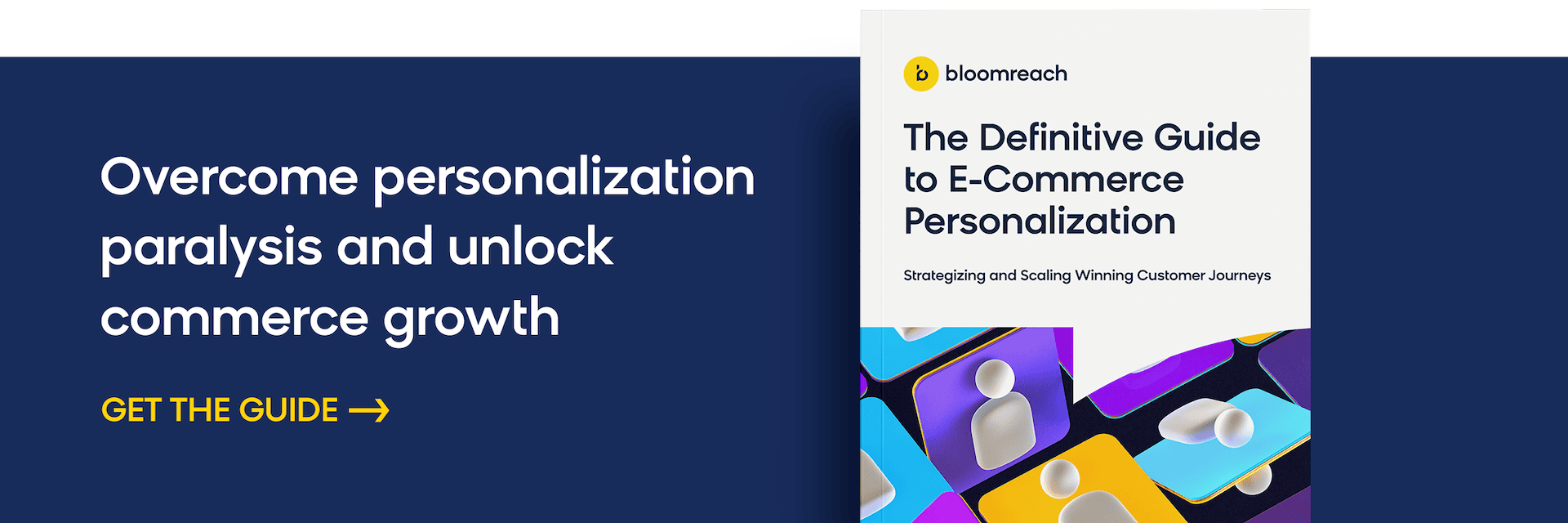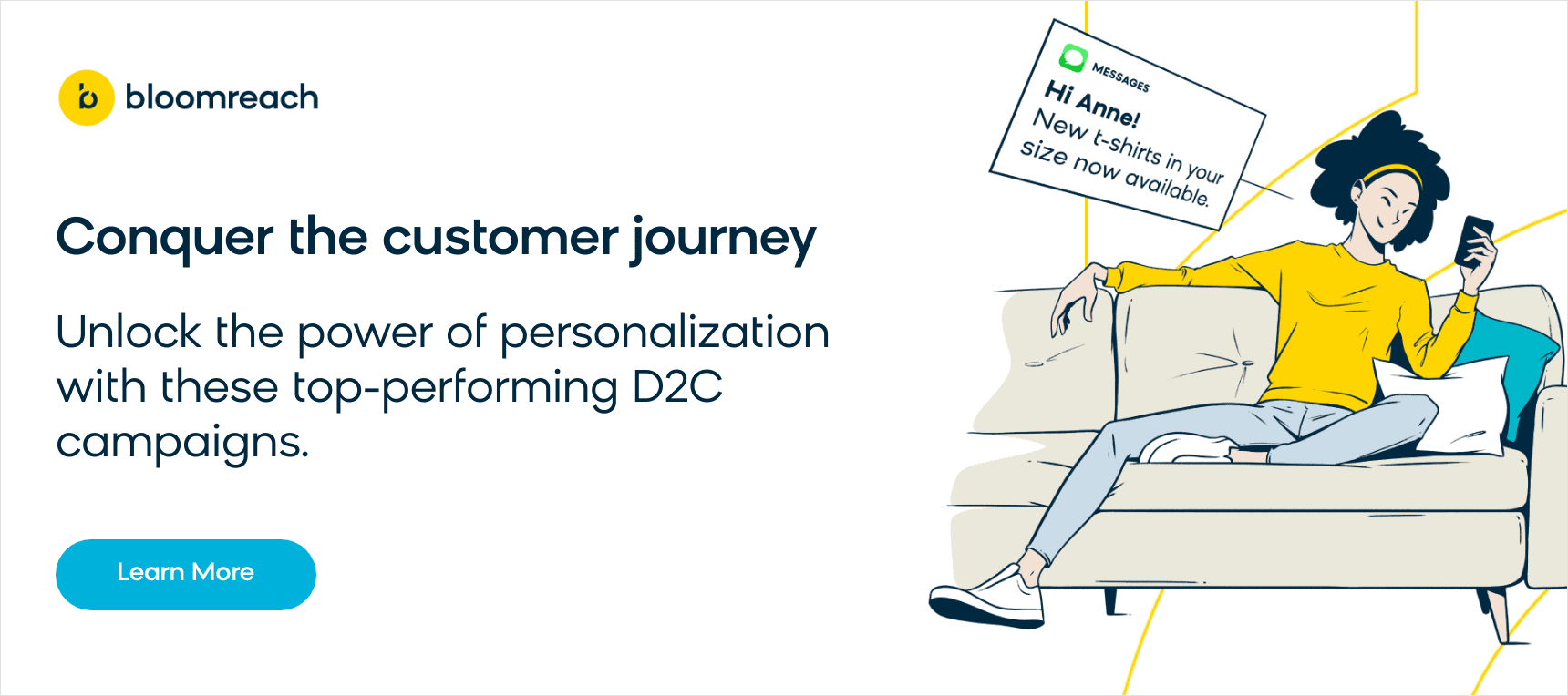Winning in digital commerce in today’s uber competitive online marketplace starts with having a top notch ecommerce data strategy that can lead to offering personalized commerce experiences for your loyal customers. Ensuring that your marketing strategy is a data-driven strategy is arguably the most important step in optimizing your marketing efforts for your ecommerce business.
One of the challenges of ecommerce personalization is how many different things it can mean to different people, teams, and organizations. While true ecommerce personalization will always be rooted in commerce data, how companies actually execute their personalization strategies will depend on where their customers are in the buyer journey.
For example, if you have a first-time visitor on your website, your personalization goal should be to deliver the best baseline experience that is technologically possible. This can include using A/B testing, a search engine that delivers relevant results, and page speed optimization to improve your new visit conversion rate and your cart completion rate.
On the opposite side of the spectrum, you have your most loyal customers who are visiting your website regularly. They may use the login feature, or make multiple purchases in a short period of time. Your company has compliantly collected so much customer data on these consumers that you can essentially create a one-to-one personalized experience for them online.
Those two examples describe scenarios commonly found in digital commerce customer journeys. There are dozens of different stops along the way on these journeys and different spots that customers find themselves in relation to how they view your brand. Ecommerce personalization strategies are beneficial every step of the way — but they must be tailored to customer behavior and the customer journey to truly be effective.
Third-party data — or aggregate data that the company does not directly collect from the customer — used to be a massive help with this and with ecommerce personalization in general. But compliance issues with the General Data Protection Regulation (GDPR) and other governing compliance regulations have made this far more difficult to use to optimize marketing campaigns.
As consumers voice more concerns around data privacy, it’s time for companies to make more of an investment into collecting zero-party and first-party data rather than continuing to rely on third-party data. This investment will allow ecommerce businesses to give consumers the option to reveal data about themselves in return for value — an exchange that is optimal for both parties.
A Winning Ecommerce Data Strategy Includes Zero-Party and First-Party Data
The key difference and benefit with zero-party and first-party is how explicit you are about collecting customer data and specifically what is shared with the customer when you do so.
Zero-Party Data
Zero-party data is data that a customer intentionally and proactively shares with your company. It can include preference center data, purchase intentions, personal contents, how an individual wants to be contacted or recognized by a brand, and so much more.
One of the biggest advantages of zero-party data is that it is usually accurate. This is because it is provided by the customer directly and companies don’t have to question the source. Since the data is freely given, there are no concerns regarding compliance about how these data points were collected.
A challenge for many companies in today’s market is the aforementioned value exchange that comes hand-in-hand with collecting zero-party data. Many consumers feel that if they are giving you their data, they should be receiving something in return.
For some, even something like a 10% off voucher to redeem at checkout next time might be enough. But others have higher expectations — that zero-party data will lead to a truly personalized experience online or other delightful business operations with your brand.
My Jewellery, a Bloomreach customer and clothing jewelry retailer in The Netherlands, took collecting zero-party data to the next level. The company created the style profile test with Bloomreach Engagement to collect data from customers in a fun and innovative way.
Customers decide whether or not they like an item that is being shown to them in a quiz-style manner by clicking either the heart or the X on the screen. After a series of products, My Jewellery is able to create a personalized style profile for customers and sends it to them via a Bloomreach Engagement email campaign.
This is just one of many interactive ways that companies are collecting zero-party data in an attempt to phase out the reliance on third-party data.
First-Party Data
First-party data is defined as information that a company collects directly via its own channels and sources. These channels include mobile apps, websites, social media, SMS, email, and more.
Since you are collecting this data yourself, it obviously makes the data unique, as no other company is able to collect these specific data points. Your company has a competitive advantage in this regard. Reliability is also greater here because you know the source where this data came from and have control over compliance.
One drawback here — is there ever enough first-party data? It seems every company wishes it had more. It takes time to collect first-party data and you’re also starting from scratch with new customers. But a lack of first-party data doesn’t necessarily have to prevent companies from personalizing experiences for customers.
One of the best ecommerce personalization strategies your company can employ with first-party data is real-time product recommendations. Bloomreach customer Yves Rocher upgraded its personalization efforts this way and increased its purchase rate by 11x on product recommendations in comparison to a more generic “top-seller” recommendation.
Yves Rocher wanted to provide the most personalized product recommendations in the ecommerce industry to both returning customers and potential customers. With Bloomreach Engagement, the company could even personalize product recommendations for anonymous guests (as long as they accepted cookie tracking).
Being able to personalize product recommendations for all of your customers is a massive advantage, and Bloomreach Engagement can do this even with only a little bit of first-party data.
Personalize Content for Customers Like You’re Old Friends
Time.com recently released an article that stated that Facebook knew its users better than their friends did. How? Simply from the data provided by Facebook users.
The average user studied by Time had 227 likes on Facebook — and this was enough information for a computer to be a better predictor of personality than this user’s friends would be.
It took just 10 likes for the computer to outperform a work colleague, 70 to do better than a friend, and 150 to beat a family member.
Now imagine if your company could collect data points to craft an ecommerce data strategy to personalize the customer experience in a similar way. If you could take in first-party data in real time and personalize search experiences and product recommendations, how many more sales could your company make?
The combination of Bloomreach Engagement and Bloomreach Discovery did just that for Jenson USA, America’s leading online bicycle retailer. Jenson USA increased revenue per visitor (RPV) by 8.5% when optimizing search results based on understanding which customer segment a visitor belongs to.
Jenson USA sharpened its focus on ecommerce personalization and moved away from manual data analyses and unscalable personalization tactics. It also concentrated on the differences between different customer segments (mountain bikers, road bikers, etc.). Bloomreach now allows Jenson USA to provide a personalized search experience based on these customer segments.
Bloomreach is the Ecommerce Personalization Leader
Whether it’s quizzes for customers to complete, personalized product recommendations, or personalized search, Bloomreach drives companies’ ecommerce personalization efforts with our Commerce Experience Cloud. Our Engagement, Discovery, and Content pillars use machine learning to allow companies to take their data-driven marketing strategy to the next level while providing predictive analytics that can help foster customer loyalty.
As the current market trends make third-party data collection riskier in terms of compliance and accuracy, make sure you’re working with a technology provider that facilitates zero-party and first-party data collection and can help your company take meaningful action with that data. Combining those two types of customer data with product data will provide your company with the commerce data fuel it needs to strategize and scale winning customer journeys.
If you’re interested in learning more about how Bloomreach can optimize your marketing strategies, customer engagement, and business outcomes, visit Bloomreach.com to learn more.


















